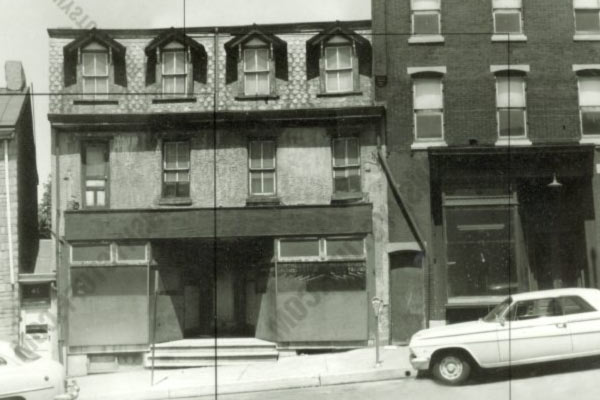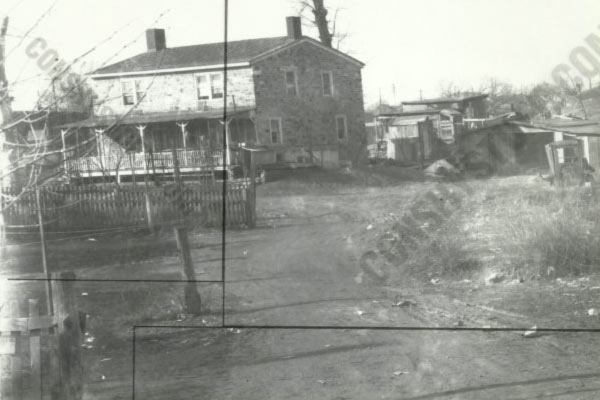
Conshohocken Movie Houses By Jack Coll
April 25, 2018
Fifty Years Ago Conshohocken – By Jack Coll
May 11, 2018Conshohocken – A Century Ago By Jack Coll

CONSHOHOCKEN—A CENTURY AGO
By Jack Coll
It was springtime in Conshohocken, the year was 1918, a hundred years ago. Trolley cars rumbled up-and-down the picturesque tree-lined Fayette Street. Trolley passengers admired the many mansions they rode past. There were the Lukens mansions, the Davis mansion, Tracy, O’Brian, Woods and Harrison mansions, all big and all beautiful.
Many of the passengers were traveling to or from Conshohocken’s shopping district once located on lower Fayette Street. There was Fred Maag’s Jewelry Store once located at 111 Fayette Street, Stewart & Forst, known as Conshohocken’s Finest Store with the most beautiful and useful things for Ladies, Misses and Children. But on most days the shopping hot-spot was Leary’s Grocery Store where Patrick Leary sold fancy dressed turkeys, chickens and live geese. West Conshohocken didn’t have a trolley line running through town but most west-side borough resident shopped at the American Store on Front Street or traveled up the hill to Fernside’s Farm, once located behind the West Conshohocken School. At Fernside’s Farm you could purchase all the usual supplies of the day plus horses and cows were bought and sold as well as pigs for sale or dressed to eat.
Other businesses operating in Conshohocken in 1918 included William Wacker, operating his Roofing business, Contractor Harry Martin, Morgan Mason, dealer in rags, paper, metal and scrap. Loella Holland cut children’s hair at 210 East Fourth Avenue, Thomas Carroll was fixing automobiles at 209 Hector Street, Plummer’s Market was located at Fayette and Elm Street, McCoy’s Drug Store was at Fourth Avenue and Fayette Street and People’s Sanitary Dairy was located at Fourth Avenue and Harry Street.
Michael Daly was operating his Marble and Granite Works on Spring Mill Avenue, Charles McGrath was operating his meats and provisions store at Sixth Avenue and Wells Street and William Neville was running his pharmacy at First Avenue and Fayette Street.
In West Conshohocken Fisher’s Cigar Store once located at Elizabeth and Ford Streets, was rumored to have sold “Moonshine” during probation. Peter McGuire ran a tobacco and candy store at Ford and Front Streets, Florence Jacobs Grocery Store was located at Ford Street and First Alley, and Thomas Matthews also ran a grocery store on Front Street below Bullock Street. Just like Conshohocken, West Conshohocken had a grocery store every other block back then.
In 1918 West Conshohocken was a thriving community, with no expressway, Blue Route, entrance and exit ramps cutting the town in half.
Conshohocken had four movie houses in 1918 including the Gem, Palace and Bijou Theatres and Little’s Opera House. A few of the hit movies of the day included, (all silent films of course) “Amarilly of Clothesline Alley,” staring Mary Pickford, ” Douglas Fairbanks and Teddy Roberts in “Arizona,” Fatty Arbuckle and Buster Keaton was in a comedy called “The Bell Boy,” Charlie Chaplin and Edna Purviance in a comedy called “A Dog’s Life,” Norma Talmadge in “The Forbidden City,” Lillian Gish and Dorothy Gish in “Hearts of the World,” and Fatty Arbuckle and Buster Keaton in “Moonshine” just to name a few.
In 1918 a new car cost under $2,000.00 and gas cost 15 cents per gallon. During the early days of the automobile cars were getting cheaper to purchase with each passing year. The average take-home pay back in 1918 was about $687.00 if you were a man. If you were a woman you could cut that in half. In 1918 there was no minimum wage except for a few states experimenting with it, and only for women and children. The federal minimum wage wouldn’t be enacted until 1938.
At a hearing in March 1915, Dorothy Miller told a state minimum wage committee in Albany, New York, that she made $6.00 per week, which came to $312.00 a year. Out of that $6.00, she paid her parents $2.50 a week for room and board. According to the New York Times, she told the committee: “After I paid my actual necessary expenses every week, I had 40 cents left for clothes and amusements. And I was the envy of all the girls I worked with.”
It seems to me that 1918 was a year for disasters. On April 21, a 6.7 San Jacinto earthquake shook Southern California with a maximum intensity causing $200,000 in damage, one person died and several more were injured.
On May 20, the small town of Codell, Kansas was hit for the third year in a row by a tornado. Coincidentally, all three tornados’s hit on May 20, 1916, 1917 and 1918 respectively.
On July 9, 1918, a great train wreck in Nashville, Tennessee, an inbound local train collided with an outbound express, killing 101 people.
On October 12, the cities of Cloquet, Minnesota and nearby areas were destroyed in a fire killing 453.
On October 25, the SS Princess Sophia sunk on Vander Reef near Juneau, Alaska, 353 people died in the greatest maritime disaster in the Pacific Northwest.
On November 1, the worst Rapid Transit accident in world history occurred under the intersection of Malbone Street and Flatbush Avenue, in Brooklyn, New York City, killing 93 people.
The following information was taken from the book
“Remembering Conshohocken and West Conshohocken”
Written By Jack Coll in 2010
Conshohocken couldn’t escape the world’s worst disaster, the influenza epidemic that swept the world in 1918, killed an estimated fifty million people. To put that number in perspective, World War I took a toll not only on Conshohocken residents but worldwide sixteen million lives were sacrificed. The influenza epidemic attacked one-fifth of the world’s population forcing the borough of Conshohocken to open a hospital to handle many of the flu-bitten residents.
The Conshohocken First Baptist Church, located at Fourth Avenue and Harry Street, opened a forty-bed hospital, and within the first five days, four patients had died and thirty-three more patients were in comfortable hospital beds receiving the best of care. The church hospital was established in a matter of a few days. The managers of the Pines offered the entire fleet of iron beds, mattresses, bedding, linens and washstands. (The Pines was a summer get-a-way for single mothers from the city of Philadelphia once located at the corner of Ridge Pike and Butler Pike.)
During the influenza epidemic of 1918 Conshohocken’s schools and church services were canceled. No public gathering of any kind was permitted, and no residents were permitted to go to funerals if it wasn’t a family member being buried. The second day the hospital was in operation, a young, pregnant woman gave birth to a healthy baby girl. Within four days, family members removed the baby and took her directly to St. Mary’s Church to be baptized.
All residents traveling outdoors were asked to wear masks over their faces, and residents who had an ill family member were forced to hang a black scarf across their front door, warning potential visitors to stay away.
The influenza epidemic was gone as quickly as it started. When it was all over, seventy-eight Conshohocken residents lost their lives to the flu, ten West Conshohocken residents died and another forty-two residents passed away from the flu in Plymouth and Whitemarsh Townships.
The First Baptist Church Hospital opened on October 12, 1918, and remained in service until October 29, 1918. Dozens of borough volunteers risked their lives to save hundreds of borough residents. Conshohocken had never had a hospital before the influenza outbreak, nor has it had one since.
When the schoolchildren were permitted to return to school later in the year, they would often play in the schoolyard, and the young girls would skip rope in rhyme with:
I had a little bird,
Its name was Enza,
I opened the window,
And in-flu-enza
On the up-side in 1918, on March 19, the United States Congress established Time Zones and approved Daylight Savings Time. And on November 11, 1918 World War I ended. Conshohocken’s resident participation during World War I was unprecedented throughout the country as the borough of Conshohocken sent more men and women off to war than any other community in America per-capita.
Returning soldiers looked forward to getting married and starting families. Most of the soldiers found work at one of the many steel and woolen mills on both sides of the river. After purchasing a house most of the families shopped for furniture at Campbell’s Furniture Store once located at Hector and Ash Streets.
In 1918 in Conshohocken there was no trash collection, residents burned their trash and garbage in a back yard trash pit. Conshohocken didn’t plow the streets of snow in 1918, but then again very few families owned automobiles a hundred years ago. Although many of the newer homes had indoor plumbing many of the houses throughout the borough still used out-houses in the back yard, where trash that wouldn’t burn like bottles would be thrown down the out-house hole.
Corner stores throughout the borough extended credit to most families in an era when there were no SUPER-MARKETS and credit cards didn’t exist.
During the summer months most residents ate dinner and would spend the evening sitting out on their front stoops watching the children play in the street, catch fire-flies and playing hide-and-seek.
Clothes were hand-washed back then, very few households owned a washing machine, and most females used the old fashioned scrub-boards. The wind played an important role in drying the clothes. Clothes were hung on backyard clotheslines, if the winds were blowing from the steel-mills towards your house, you didn’t hang clothes that day. If you choose to hang your clothes on a windy day when the wind was blowing towards your house your clothing would be covered with black soot from the mills and would need another washing.
Most of the many mills ran three shifts constituting our many drinking establishments to stay open 24 hours a day. Most of the mill workers would always stop for two, or three or four drinks on the way home to wash the soot out of their throat. Safety in the mills back then wasn’t a priority so breathing mask weren’t supplied to the employees. The mills weren’t much for supporting workers compensation either, if you got hurt on the job you were out of a job until you were able to return, the time you spent out injured was un-paid.
Most of the mill workers put in a 45-50 hour work week, always finishing at 12:00 noon on Saturday where employees of Alan Wood Steel would stop at the payroll office to pick up their pay in cash, and from the payroll office many of them headed straight to the bar or hotel where the drinks flowed like the mighty Schuylkill River after a hard rain. Many of the steel workers would drink through the afternoon into the late evening complete with debates, arguing, and fist-a-cuffs. It was said in the early days of last century that more steel was made in the taprooms on Saturday afternoon then was actually made at the mills during the week. Many of the wives would know to show up at the bar to claim some of their husband’s paycheck for groceries before the money was all spent at the bar.
Children stayed busy back then by swimming in the old canal or river in the summertime and ice skating in the winter, ice skating on the river was very popular back then.
Ahh, life was good in Conshohocken a hundred years ago, I’m sure there was a lot of complaining a century ago, just like there is a lot of complaining today. It’s funny to think about everything that’s changed in a hundred years and funny how some things have stayed the same.
And that my friends is the way it was all those years ago.
Stay tuned for next week on Conshystuff, we’ll look back fifty years to 1968, It wasn’t all about Peace, Love and Rock-and-Roll.
THANKS FOR THE MEMORIES!

